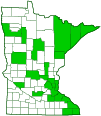Trembling Phlebia
(Phlebia tremellosa)
Conservation • Description • Habitat • Biology • Distribution • Taxonomy
Conservation Status |
|
|||||||
| IUCN Red List | not listed |
|||||||
| NatureServe | not listed |
|||||||
| Minnesota | not listed |
|||||||
Description |
||
Trembling Phlebia is a wood-rotting fungus. It is found in Europe, Asia, and North and Central America. In the united States it is common from the East Coast to the Midwest and on the West Coast. It is less common in Minnesota, where it is at the western edge of its range. It obtains its nutrients from dead wood (saprobic). It grows flat (resupinate), alone or in groups, mostly on stumps and fallen branches of deciduous trees, especially oak and beech, occasionally also on wood of coniferous trees. It sometimes appears in overlapping clusters. The fruiting body is a 2″ to 4″ long, ¾″ to 1½″ wide, irregularly shaped patch of pore surface spread out flat (effused) on a branch or log (substrate). It is pale and lies completely flat (resupinate) when young. As it matures it darkens and the upper edge folds back more than 90° creating a bracket-like cap. Adjacent patches often fuse together covering extensive areas. The lower surface is the only visible part when no caps are present. It is yellowish to brownish-orange to pinkish-orange when young, becoming orange to red when mature. The flesh is translucent, flexible, rubbery, and somewhat jelly-like. It has a shallow, elaborate network of narrow ridges, 1 ⁄32″ to 1 ⁄16″ wide furrows, and crossveins. It looks something like a tube surfacebut unlike a true tube surface, spore-producing structures (basidia) cover the entire networked layer. The caps, when present, are narrow, up to ¾″ long, white to pale yellow, and densely covered with woolly hairs. There is no stem. The flesh is very thin, whitish, and waxy or gelatinous. It is not edible. The spore print is white. |
||
Similar Species |
||
Wrinkled Crust (Phlebia radiata) does not produce caps. |
||
Habitat and Hosts |
||
Mostly hardwoods, especially oak and beech |
||
Biology |
||
Season |
||
Late spring through fall |
||
Distribution |
||||
|
Sources |
|||
| 10/16/2021 | ||||
Occurrence |
||||
Widespread and common |
||||
Taxonomy |
|||
| Kingdom | Fungi (fungi) | ||
| Subkingdom | Dikarya | ||
| Phylum | Basidiomycota (club fungi) | ||
| Subphylum | Agaricomycotina (jelly fungi, yeasts, and mushrooms) | ||
| Class | Agaricomycetes (mushroom-forming fungi) | ||
| Subclass | Agaricomycetidae | ||
| Order | Polyporales (shelf fungi) | ||
| Family | Meruliaceae | ||
| Genus | Phlebia | ||
This species was formerly classified as Merulius tremellosus. In 1984 it was transferred to the genus Phlebia. A recent DNA study (Monclavo et al., 2002) showed the the genus Phlebia is probably polyphyletic, containing unrelated species. However, Phlebia tremellosa is part of a group that clearly belongs to the genus Phlebia. |
|||
Synonyms |
|||
Merulius imbricatus Merulius spongiosus Merulius tremellosus Sesia tremellosa Xylomyzon tremellosum |
|||
Common Names |
|||
Jelly Rot Trembling Merulius Trembling Phlebia |
|||
Glossary
Basidium
A microscopic, club-shaped structure on the underside of the cap of club fungi that produces spores. Plural: basidia.
Resupinate
In fungi: referring to the fruiting body lying flat on the surface of the substrate, without a stalk or a cap.
Saprobic
Obtaining nutrients from non-living organic matter, such as decaying plant or animal matter.
Visitor Photos |
|||||
Share your photo of this fungus. |
|||||
| This button not working for you? Simply email us at info@MinnesotaSeasons.com. Attach one or more photos and, if you like, a caption. |
|||||
Luciearl |
|||||
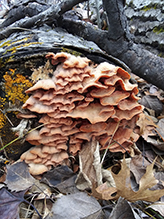 |
|||||
Found a lot of this fungus on several downed trees. |
|||||
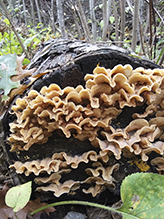 |
|||||
Fairview Twp., Cass County |
|||||
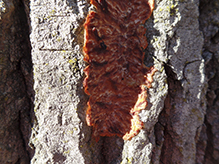 |
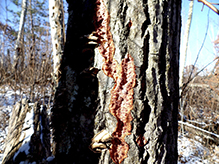 |
||||
I believe these were all on a large downed poplar. |
|||||
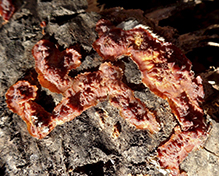 |
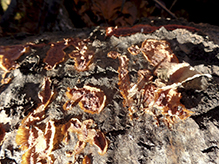 |
||||
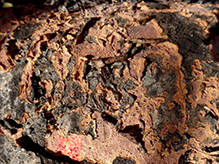 |
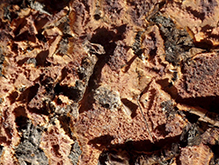 |
||||
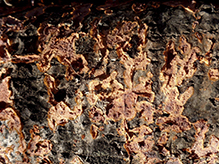 |
|||||
MinnesotaSeasons.com Photos |
|||||
|
|||||

Slideshows |
||

Visitor Videos |
|||
Share your video of this fungus. |
|||
| This button not working for you? Simply email us at info@MinnesotaSeasons.com. Attach a video, a YouTube link, or a cloud storage link. |
|||
Other Videos |
|||
| Żylak trzęsakowaty (Phlebia tremellosa) Jaworzno Paul and Mushrooms |
|||
About
Published on Nov 1, 2017 |
|||
| Jelly Rot Fungus - Trembling Merulius - Rotsveppir - Geislahrúður - Sveppir Hellen Linda Drake |
|||
About
Published on Feb 21, 2014 Jelly Rot Fungus - Phlebia tremellosa - Merulius tremellosus. - Meruliaceae - Kniplingsætt - Sveppaætt - Phlebia radiate - Geislahrúður Phlebia means "veins"; tremellosa means "trembling." Its typical form is a classic example of what mycologists call an "effused-reflexed" fruiting body; it spreads its spore-bearing surface over the wood and musters up just enough cap-making umph to fold over its upper edge into a slight extension. Other distinguishing features include the translucent, orangish to pinkish spore-bearing surface, which develops deep folds and pockets; the whitish, hairy upper edge; growing alone to gregariously, sometimes in overlapping clusters; found primarily on the dead wood of hardwoods but also reported on conifer wood; causing a white rot; See more: http://www.mushroomexpert.com/phlebia_tremellosa.html Upper surface: Caps white to pale yellow; hairy, wooly. Pore surface: Pore-like with a network of radiating folds, ridges, and crossveins; yellowish to brownish-orange to pinkish-orange; rubbery, flexible, and gelatinous. Edibility: Inedible. : https://www.messiah.edu/Oakes/fungi_on_wood//poroid%20fungi/species%20pages/Phlebia%20tremellosa.htm Caps white to pale yellow; hairy, woolly. These soft and flexible bracket-like growths often fuse laterally to form more extensive sheets. Habitat : Mostly on decaying deciduous wood. Fairly frequent and widespread in Britain. See more: https://www.naturespot.org.uk/species/jelly-rot-fungus Hérna er að finna mikinn fróðleik um alskonar sveppi eins og rotsveppi af Kniplingsætt (Meruliaceae) : https://is.wikipedia.org/wiki/Notandi:Akigka/Sveppir_%C3%A1_%C3%8Dslandi Fungi, Basidiomycota, Agaricomycotina, Agaricomycetes, Polyporales, Meruliaceae, Phlebia. |
|||


Created: 10/28/2018
Last Updated:
